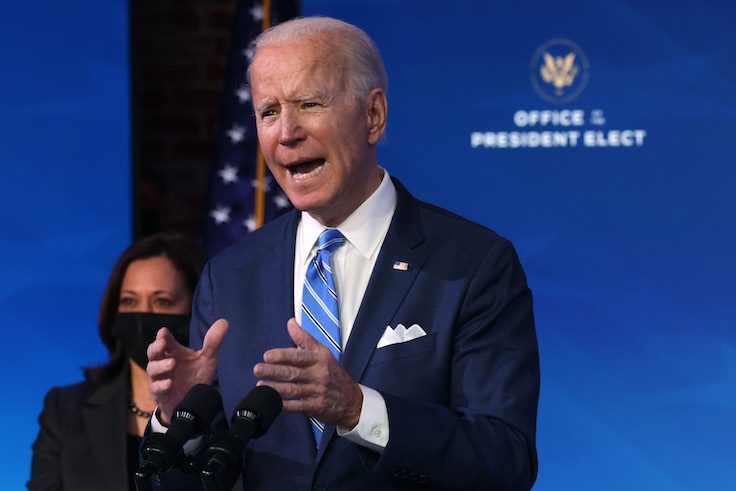President-elect Joe Biden on Thursday evening called for Congress to pour another $1.9 trillion into the economy, boosting spending on the COVID crisis by just shy of 50 percent in a move that some economists argue wildly overshoots the economy's needs.
The plan includes billions of dollars for added public health response, but is in large part focused on massive transfers, including expanding relief payments that would flow even to some of the wealthiest taxpayers. It also includes some of Biden's longer-term fiscal policy priorities, including a minimum wage hike to $15 per hour—which could cost a recovering economy millions of jobs.
The Biden plan would bring total spending on the COVID crisis to roughly $6 trillion, the single biggest fiscal response in American history, and one that has produced record deficits. But that is only the beginning, as his team has promised further spending in the form of a second bill expected in time for Biden's first address to Congress in February.
The sheer scale of Biden's ask not only risks a major blow to the federal debt—it also may be too big of an ask for congressional Republicans, who initially shied away from a much smaller package passed in December. That means the proposal could prompt a contentious fight on top of an expected impeachment trial for outgoing president Donald Trump—a rocky beginning to Biden's term.
The plan floated Thursday would go big on every front possible. The biggest ticket item is the expansion of the $600 recovery rebate checks from December's bill to $2,000 per person, at an estimated cost of $465 billion. The expanded relief checks were likely a key political promise that helped Democrats win the Senate earlier this month, but they have attracted criticism for likely disbursing relief to high-earning households that do not need the aid.
The plan would also allocate extensive funding for the actual public health demands of COVID, an area that has received short shrift in previous bills. That includes $20 billion for a national vaccine program, $50 billion for scaled-up testing, and massive investment in expanding the public health workforce.
The remainder of the plan bulks out preexisting spending categories while adding new ones. That includes funding to extend the $400 federal "bonus" unemployment insurance through September, and some $30 billion in rental assistance. It also includes proposals like the minimum wage hike—which could kill nearly four million jobs even if phased in over the next four years.
Marc Goldwein, senior policy director at the deficit watchdog Committee for a Responsible Federal Budget, told the Washington Free Beacon that he is "glad Biden is focused on the economy and the pandemic," and sees "lots of the right types of policies" in the bill, but thinks the administration will need to "work with Congress to negotiate something a bit more targeted, since it's a lot of fiscal support relative to what the economy needs."
The bill comes on the tail of a just-passed $935 billion relief bill, which the CRFB estimated would more than account for lost economic output in 2021 and would "propel personal income to record levels in the first quarter of 2021." Jason Furman, a Harvard economist who served as chair of the Council of Economic Advisers under Barack Obama, noted that adding Biden's $1.9 trillion proposal would add roughly $300 billion per month to the economy—nearly four times the estimated lost productivity.
Similar excess spending is apparent in the rest of the bill. It would allocate $350 billion to state and local government aid, which tax policy analyst Scott Greenberg noted would dramatically exceed estimated state and local revenue shortfalls, which are only down about $8 billion. The extension of unemployment insurance, similarly, would likely cover more than most workers' lost wages, potentially slowing economic recovery in the second half of the year by discouraging a return to work, just as the hiked minimum wage would depress employment.
The Biden campaign on Thursday dismissed the December bill as "only a down payment" that "fell far short of the resources needed to tackle the immediate crisis." It also does not think that just one $1.9 trillion bill is enough: The coming "recovery" proposal could add trillions in additional spending, focused on infrastructure and "green jobs."
The real question, however, is whether either proposal could make it through Congress. Although Democrats control both chambers, they lack a filibuster-proof majority in the Senate. The Biden team has intimated that they do not want to pass the proposal through reconciliation—a special process that allows certain spending bills to pass the Senate with only a majority vote—but want to make a deal with Republicans for bipartisan relief.
That may be a tough sell, as many Senate Republicans were already uncomfortable with added spending during the negotiations of December's $935 billion bill—six voted against it. Senate Democratic leadership is likely to see particular recalcitrance as they ask Republicans not only to consider more relief but also to oversee another impeachment trial for Trump, which is likely to begin in the new session.
Those stakes mean Biden's reputation as a dealmaker will be tested within days of taking office. He could wring another major spending bill out of his former Republican Senate colleagues—or he could see either his plan go up in acrimonious smoke, or a dramatic end to the Senate filibuster once and for all.
